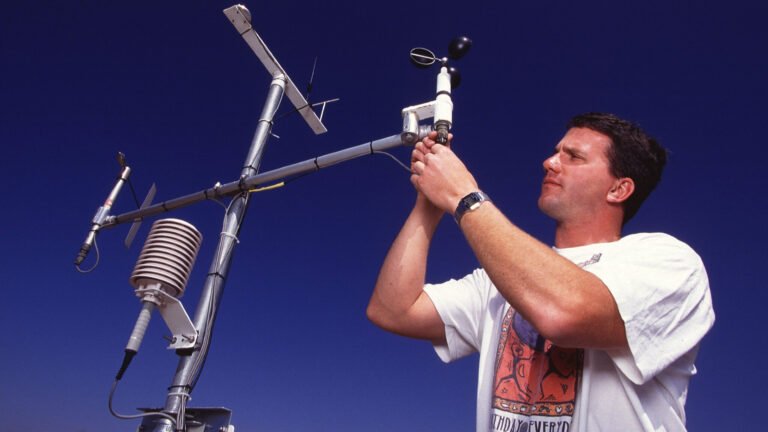
Contents
Revolutionizing Weather Forecasting: How AI is Transforming the Lives of Farmers Worldwide
A new wave of AI-powered weather forecasting models is poised to revolutionize the way farmers make decisions, providing them with accurate and localized predictions to help them navigate the challenges of climate change. With the potential to deliver high-resolution forecasts globally within seconds on a single laptop or desktop computer, AI weather forecasting is set to become a game-changer for farmers around the world.
For farmers, every planting decision carries risks, and many of those risks are increasing with climate change. One of the most consequential is weather, which can damage crop yields and livelihoods. A delayed monsoon, for example, can force a rice farmer in South Asia to replant or switch crops altogether, losing both time and income. Access to reliable, timely weather forecasts can help farmers prepare for the weeks ahead, find the best time to plant or determine how much fertilizer will be needed, resulting in better crop yields and lower costs.
Why AI Forecasting Matters Now
The physics-based weather prediction models used by major meteorological centers around the world are powerful but costly. They simulate atmospheric physics to forecast weather conditions ahead, but they require expensive computing infrastructure. The cost puts them out of reach for most developing countries. Moreover, these models have mainly been developed by and optimized for northern countries. They tend to focus on temperate, high-income regions and pay less attention to the tropics, where many low- and middle-income countries are located.
A major shift in weather models began in 2022 as industry and university researchers developed deep learning models that could generate accurate short- and medium-range forecasts for locations around the globe up to two weeks ahead. These models worked at speeds several orders of magnitude faster than physics-based models, and they could run on laptops instead of supercomputers. Newer models, such as Pangu-Weather and GraphCast, have matched or even outperformed leading physics-based systems for some predictions, such as temperature.
Key highlights of AI weather forecasting include:
* High-resolution forecasts globally within seconds on a single laptop or desktop computer
* Dramatically less computing power required compared to traditional physics-based models
* Potential to provide accurate, localized predictions at a fraction of the computational cost of conventional models
* Ability to run on laptops instead of supercomputers
Benefits of AI Weather Forecasting
AI weather forecasting offers several benefits, including:
* Improved crop yields and lower costs
* Enhanced decision-making for farmers
* Increased accuracy and reliability of weather forecasts
* Potential to provide forecasts weeks to months ahead, helping farmers make informed planting choices
* Ability to predict extreme weather events, such as extratropical cyclones and abnormal rainfall
Tailoring Forecasts for Real-World Decisions
While AI weather models offer impressive technical capabilities, they are not plug-and-play solutions. Their impact depends on how well they are calibrated to local weather, benchmarked against real-world agricultural conditions, and aligned with the actual decisions farmers need to make, such as what and when to plant, or when drought is likely. To unlock its full potential, AI forecasting must be connected to the people whose decisions it’s meant to guide.
Groups such as AIM for Scale, a collaboration of researchers in public policy and sustainability, are helping governments to develop AI tools that meet real-world needs, including training users and tailoring forecasts to farmers’ needs. International development institutions and the World Meteorological Organization are also working to expand access to AI forecasting models in low- and middle-income countries.
Case Study: India
A recent study in India found that when farmers received more accurate monsoon forecasts, they made more informed decisions about what and how much to plant – or whether to plant at all – resulting in better investment outcomes and reduced risk. This study highlights the potential of AI weather forecasting to improve the lives of farmers in developing countries.
A New Era in Climate Adaptation
AI weather forecasting has reached a pivotal moment. Tools that were experimental just five years ago are now being integrated into government weather forecasting systems. But technology alone won’t change lives. With support, low- and middle-income countries can build the capacity to generate, evaluate and act on their own forecasts, providing valuable information to farmers that has long been missing in weather services.
Conclusion:
AI weather forecasting is poised to revolutionize the way farmers make decisions, providing them with accurate and localized predictions to help them navigate the challenges of climate change. With its potential to deliver high-resolution forecasts globally within seconds on a single laptop or desktop computer, AI weather forecasting is set to become a game-changer for farmers around the world. As research continues to advance and more countries begin to adopt AI weather forecasting, we can expect to see significant improvements in crop yields, lower costs, and enhanced decision-making for farmers.
Keywords: AI weather forecasting, climate change, farmers, crop yields, decision-making, physics-based models, deep learning models, Pangu-Weather, GraphCast, AIM for Scale, World Meteorological Organization, India, monsoon forecasts, climate adaptation.
Hashtags: #AIWeatherForecasting #ClimateChange #Farmers #CropYields #DecisionMaking #Sustainability #ClimateAdaptation #WeatherForecasting #Agriculture #Technology #Innovation #FoodSecurity #ClimateResilience #SustainableAgriculture #AIForGood #WeatherPrediction #ClimateAction #FarmersLivesMatter #AgriculturalInnovation #ClimateSmartAgriculture #WeatherIntelligence #AIForecasting #ClimateForecasting #FarmersDecisionMaking #CropManagement #WeatherRiskManagement #ClimateRiskManagement #SustainableDevelopment #GlobalFoodSecurity #AgriculturalProductivity #ClimateResilientAgriculture #AIForSustainability #WeatherAndClimate #AgriculturalTechnology #InnovationInAgriculture #ClimateChangeMitigation #AdaptationToClimateChange #WeatherAndAgriculture #AgriculturalInnovationSystems #ClimateInformationServices #WeatherForecastingForAgriculture #AgriculturalDecisionMaking #ClimateSmartDecisionMaking #SustainableAgriculturalPractices #ResilientAgriculture #ClimateResilientFoodSystems #AgriculturalInnovationAndClimateChange #AIAndClimateChange #WeatherAndClimateServices #AgriculturalProductivityAndClimateChange #SustainableAgricultureAndClimateChange #ClimateChangeAndFoodSecurity #AgriculturalInnovationAndSustainability #AIForClimateAction #ClimateActionAndAgriculture #SustainableAgricultureAndClimateAction #ClimateResilientAgricultureAndFoodSecurity.
Source link